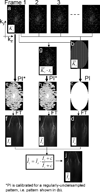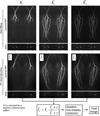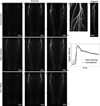Interleaved variable density sampling with a constrained parallel imaging reconstruction for dynamic contrast-enhanced MR angiography
- PMID: 21360740
- PMCID: PMC3552437
- DOI: 10.1002/mrm.22814
Interleaved variable density sampling with a constrained parallel imaging reconstruction for dynamic contrast-enhanced MR angiography
Abstract
For MR applications such as contrast-enhanced MR angiography, it is desirable to achieve simultaneously high spatial and temporal resolution. The current clinical standard uses view-sharing methods combined with parallel imaging; however, this approach still provides limited spatial and temporal resolution. To improve on the clinical standard, we present an interleaved variable density (IVD) sampling method that pseudorandomly undersamples each individual frame of a 3D Cartesian ky-kz plane combined with parallel imaging acceleration. From this dataset, time-resolved images are reconstructed with a method that combines parallel imaging with a multiplicative constraint. Total acceleration factors on the order of 20 are achieved for contrast-enhanced MR angiography of the lower extremities, and improvements in temporal fidelity of the depiction of the contrast bolus passage are demonstrated relative to the clinical standard.
Copyright © 2011 Wiley-Liss, Inc.
Figures





References
-
- Zhang H, Maki JH, Prince MR. 3D contrast-enhanced MR angiography. J Magn Reson Imaging. 2007;25(1):13–25. - PubMed
-
- Haider CR, Glockner JF, Vrtiska TJ, Macedo TA, Borisch EA, Riederer SJ. A Comparison of Time-Resolved 3D CE-MRA with Peripheral Run-off CTA in the Calves. East Lansing, MI: MR Angio Club; 2009.
-
- Du J. Contrast-enhanced MR angiography using time resolved interleaved projection sampling with three-dimensional cartesian phase and slice encoding (TRIPPS) Magn Reson Med. 2009;61(4):918–924. - PubMed
-
- Lustig M, Donoho D, Pauly JM. Sparse MRI: The application of compressed sensing for rapid MR imaging. Magn Reson Med. 2007;58(6):1182–1195. - PubMed
Publication types
MeSH terms
Substances
Grants and funding
LinkOut - more resources
Full Text Sources
Other Literature Sources

